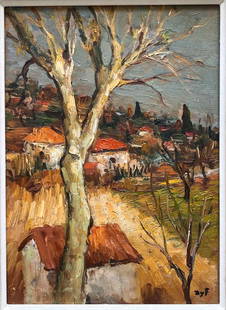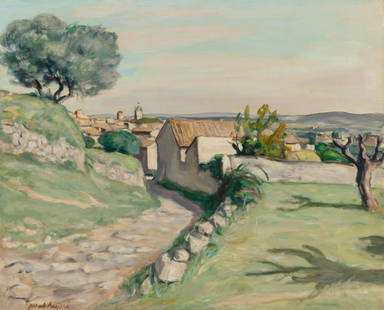

 Discovery- InteriorsBonhamsSponsored.Your ad here?
Discovery- InteriorsBonhamsSponsored.Your ad here?



Discovery- Interiors
Bonhams
Sponsored.Your ad here?


 Discovery- InteriorsBonhamsSponsored.Your ad here?
Discovery- InteriorsBonhamsSponsored.Your ad here?



Discovery- Interiors
Bonhams
Sponsored.Your ad here?

CONSTANTINOS MALEAS (1879-1928) Vue de l'Acropole
Similar Sale History
Recommended Items



Item Details
Description
CONSTANTINOS MALEAS (1879-1928)
Vue de l'Acropole
signé en grec en bas à gauche
huile sur carton
59,5 x 83 cm. (23 7/16 x 32 11/16in.)
Peint c. 1918-1919.
signed in Greek lower left
oil on card
Footnotes:
Expositions
Athens, Exhibition Hall of the Anatoli company, Exhibition of Paintings by C. Maleas, January 1919 (possibly).
Paris, Galerie de la Boetiè, Group Techni (Ouevres d'un Groupe d'Artistes Héllènes), September 1-30, 1919 (possibly).
Uniting a timeless world of ideal rhythms with the exuberance and zest of Attica's nature, Maleas captures the grandeur of the classical monument not as a lifeless relic of ancient glory but as a form of eternity constantly reborn in the present. While setting his easel and standing defiantly before the Acropolis, he is in search of new expressive forms and a deeper pictorial truth. This was also the quest of the revolutionary 'Omas Techni' art group, which was founded around the same time and had already infused the forces of renewal in Greek painting with a fresh and vital impetus.
Maleas's return to Athens in 1917 afforded him the opportunity to concentrate on the sacred rock, something he couldn't do during his brief visits in the past when he lived in Thessaloniki. As noted by Dr. S. Lydakis, 'his permanent residence in Athens signalled a new period in his work. Experimentation subsided and the admirable maturity of his paintings showed that the artist was at the height of his creative powers.'¹
Here, he chose a western vantage point because it offered him one of the best views of the citadel as a harmonious ensemble of illustrious monuments—the majestic Propylaea and the Parthenon, this classical masterpiece and timeless symbol of ordered thought and everlasting value. Painting outdoors among pine trees, aloes, and cypresses, Maleas was able to retain the freshness of execution and fidelity to nature's effects, aiming not to produce a romanticised view of ancient splendour or a picturesque scene of evocative detail, but to investigate and solve pictorial issues beyond the mere recording of a specific location. 'Since his early output, the one element that defined Maleas's art above anything else was his effort to organise the pictorial space as a system of forms, where nothing was random and everything followed a compositional plan that constituted a new reality.'²
Although Maleas painted what was in front of him with complete directness, he did so with a deep understanding of the landscape as a complex entity. While entrusting his subject to the truth of vision, he also ventured beyond atmospheric effects to penetrate the inner world of the landscape and become part of its reality.³ He sought an underlying structure for his studies on colour, paint and light, a kind of sturdy pictorial scaffolding that would allow him to convey a sense of endurance and permanence akin to the atmosphere emanating from the awesome site. His architectural studies helped him fully comprehend the teachings of Cezanne, who had exhorted painters to look for solidity beneath the surface patterns and treat their subjects in terms of primary geometric forms to discover their enduring character and essential content.
Moreover, this captivating view of the Acropolis showcases the artist's predilection for curvilinear motifs and rhythmic patterns that invest the picture with fluid art-nouveau touches. Its wonderful colours—including a set of eye-smacking mauves and lavenders that instantly recall Parthenis's Alentours de l'Acropole⁴—move it towards the poetic atmosphere of symbolism. It can be argued that, judging from the predominance of elaborate natural motifs, the painter intended to submit the man-made environment to a natural order. As noted by Professor A. Kotidis in his monograph on the artist, 'this is an eloquent allusion, typical of Maleas's symbolism: human creations are finite and transient, while nature is infinite and eternal.'⁵ Another reading, equally symbolist, may suggest that the painter aspired to a creative fusion of nature and culture on equal terms: as much awesome as nature may be, the Parthenon's timeless beauty is nothing short of miraculous.
¹. S. Lydakis, 'Constantinos Maleas' [in Greek] in The Greek Painters - 20th Century, vol. II, Melissa editions, Athens 1975, p. 61.
². A. Kotidis, Constantinos Maleas [in Greek], Adam editions, Athens 2000, p. 188.
³. See H. Kambouridis - G. Levounis, Modern Greek Art - the 20th Century, Ministry of the Aegean edition, Athens 1999, p.30.
⁴. Sold by Bonhams - Cornette de Saint Cyr, Greek Sale, November 22, 2023, lot 9.
⁵. A. Kotidis, Constantinos Maleas, p. 155.
Vue de l'Acropole
signé en grec en bas à gauche
huile sur carton
59,5 x 83 cm. (23 7/16 x 32 11/16in.)
Peint c. 1918-1919.
signed in Greek lower left
oil on card
Footnotes:
Expositions
Athens, Exhibition Hall of the Anatoli company, Exhibition of Paintings by C. Maleas, January 1919 (possibly).
Paris, Galerie de la Boetiè, Group Techni (Ouevres d'un Groupe d'Artistes Héllènes), September 1-30, 1919 (possibly).
Uniting a timeless world of ideal rhythms with the exuberance and zest of Attica's nature, Maleas captures the grandeur of the classical monument not as a lifeless relic of ancient glory but as a form of eternity constantly reborn in the present. While setting his easel and standing defiantly before the Acropolis, he is in search of new expressive forms and a deeper pictorial truth. This was also the quest of the revolutionary 'Omas Techni' art group, which was founded around the same time and had already infused the forces of renewal in Greek painting with a fresh and vital impetus.
Maleas's return to Athens in 1917 afforded him the opportunity to concentrate on the sacred rock, something he couldn't do during his brief visits in the past when he lived in Thessaloniki. As noted by Dr. S. Lydakis, 'his permanent residence in Athens signalled a new period in his work. Experimentation subsided and the admirable maturity of his paintings showed that the artist was at the height of his creative powers.'¹
Here, he chose a western vantage point because it offered him one of the best views of the citadel as a harmonious ensemble of illustrious monuments—the majestic Propylaea and the Parthenon, this classical masterpiece and timeless symbol of ordered thought and everlasting value. Painting outdoors among pine trees, aloes, and cypresses, Maleas was able to retain the freshness of execution and fidelity to nature's effects, aiming not to produce a romanticised view of ancient splendour or a picturesque scene of evocative detail, but to investigate and solve pictorial issues beyond the mere recording of a specific location. 'Since his early output, the one element that defined Maleas's art above anything else was his effort to organise the pictorial space as a system of forms, where nothing was random and everything followed a compositional plan that constituted a new reality.'²
Although Maleas painted what was in front of him with complete directness, he did so with a deep understanding of the landscape as a complex entity. While entrusting his subject to the truth of vision, he also ventured beyond atmospheric effects to penetrate the inner world of the landscape and become part of its reality.³ He sought an underlying structure for his studies on colour, paint and light, a kind of sturdy pictorial scaffolding that would allow him to convey a sense of endurance and permanence akin to the atmosphere emanating from the awesome site. His architectural studies helped him fully comprehend the teachings of Cezanne, who had exhorted painters to look for solidity beneath the surface patterns and treat their subjects in terms of primary geometric forms to discover their enduring character and essential content.
Moreover, this captivating view of the Acropolis showcases the artist's predilection for curvilinear motifs and rhythmic patterns that invest the picture with fluid art-nouveau touches. Its wonderful colours—including a set of eye-smacking mauves and lavenders that instantly recall Parthenis's Alentours de l'Acropole⁴—move it towards the poetic atmosphere of symbolism. It can be argued that, judging from the predominance of elaborate natural motifs, the painter intended to submit the man-made environment to a natural order. As noted by Professor A. Kotidis in his monograph on the artist, 'this is an eloquent allusion, typical of Maleas's symbolism: human creations are finite and transient, while nature is infinite and eternal.'⁵ Another reading, equally symbolist, may suggest that the painter aspired to a creative fusion of nature and culture on equal terms: as much awesome as nature may be, the Parthenon's timeless beauty is nothing short of miraculous.
¹. S. Lydakis, 'Constantinos Maleas' [in Greek] in The Greek Painters - 20th Century, vol. II, Melissa editions, Athens 1975, p. 61.
². A. Kotidis, Constantinos Maleas [in Greek], Adam editions, Athens 2000, p. 188.
³. See H. Kambouridis - G. Levounis, Modern Greek Art - the 20th Century, Ministry of the Aegean edition, Athens 1999, p.30.
⁴. Sold by Bonhams - Cornette de Saint Cyr, Greek Sale, November 22, 2023, lot 9.
⁵. A. Kotidis, Constantinos Maleas, p. 155.
Condition
There is a very minor surface dent to the lower left region – some light aging of the varnish upper left and right region –
very slight bulging of the card board surface which is habitual for works of this size by the artist .
Otherwise is very good stable condition.
very slight bulging of the card board surface which is habitual for works of this size by the artist .
Otherwise is very good stable condition.
Buyer's Premium
- 28% up to €40,000.00
- 27% up to €800,000.00
- 21% above €800,000.00
CONSTANTINOS MALEAS (1879-1928) Vue de l'Acropole
Estimate €25,000 - €35,000
4 bidders are watching this item.
Shipping & Pickup Options
Item located in Paris, France, frSee Policy for Shipping
Payment

Related Searches
TOP
































![After Pierre Auguste RENOIR: Vue De Cagnes, France: After Pierre Auguste Renoir (French 1841-1919) An ornately gilt framed modern reproduction painted homage to Renoir depicting figures in landscape. [Frame: 22" H x 28" W]. Provenance: From the Estate](https://p1.liveauctioneers.com/1221/326908/176008946_1_x.jpg?height=310&quality=70&version=1713556292)














